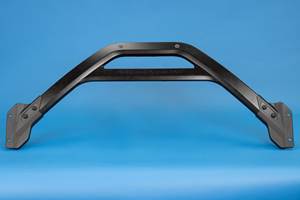Hybrid composite materials: tailoring for specific performance
I received a link to an interesting technical paper presented at CAMX by AGY (Aiken, SC, US). It got me thinking about hybrid composites.

PlastiComp’s Complēt Hybrid glass/carbon compound.
CAMX 2017 turned out to be a great success, despite having been cancelled due to Hurricane Irma in September. The rescheduled event still attracted the vast majority of the original exhibitors, and more than 6500 visitors (see our News item that wraps up the 2017 edition of the show, here: —https://www.compositesworld.com/news/camx-2017-a-strong-event). Following the show, I received a link to an interesting technical paper presented at CAMX by AGY Holding Corp. (Aiken, SC, US), authored by Craig Homrighausen, Scott Damron and Mike Palmer, entitled “Hybrid composites based on discontinuous S-2 Glass and carbon fiber reinforced nylon” (here’s the link to the technical paper in full: https://www.agy.com/wp-content/uploads/2018/01/Hybidization-of-S2-and-Carbon-CAMX-Final-12-15-17.pdf). It got me thinking about hybrid composites.
If two materials (resin and fiber) can be combined to form a new material that’s better than either of the starting materials — the definition of a composite — then hybrid composites go one step further, whereby the composite is optimized for specific, and better, properties (and often better economics) by combining three or more materials. This concept is not new, but research and development is growing and use of hybrids is expanding, particularly into cost-sensitive automotive applications. By judiciously combining glass fiber with carbon, for example, one can achieve satisfactory mechanicals at a better price point.
As explained in AGY’s paper, by combining the company’s trademarked S-2 Glass fibers in short, chopped form with short carbon fibers in a thermoplastic matrix, impact resistance can be improved, while preserving the load-bearing capability (strength) of the carbon with minimal reduction in stiffness. The paper looked at random fiber hybrids, where short S-2 Glass fiber is combined with short carbon fiber and Nylon 6/6 during extrusion compounding to produce a blended composition pellet. Using a design of experiments (DOE) approach, the authors injection-molded test specimens with a range of carbon and glass fiber volumes. The results showed that the optimum composition for maximizing strength, modulus and flexural strength of the hybrid composite system is approximately 12 volume% S-2 Glass fiber and 3 volume% carbon fiber, or about 23% (by weight) S-2 Glass to 5% (by weight) carbon fiber, say the authors. Notched Izod impact tests also showed improved impact performance. The bottom line: These hybrid compositions can be useful for applications where strength and impact resistance are key design drivers but where stiffness cannot be sacrificed. (If you want more information on the research, contact AGY’s Iain Montgomery at 803 643 1101.)
Such hybrid composite thermoplastics as described above are available from several suppliers, including RTP Company (Winona, MN, US) and PlastiComp Inc. (Winona, MN, US). PlastiComp has offered hybrid glass/carbon thermoplastic molding compounds, under the brand name Complēt Hybrid for several years, say Kirk Fratzke, marketing communications manager, and Eric Wollan, vice president and chief operating officer. “Using glass as an economic diluent adds impact strength performance to counteract carbon fiber’s brittleness,” says Wollan. In general, says Fratzke, PlastiComp has found that hybrid product formulations with lower carbon fiber weight percentages (5-15%) combined with moderate glass fiber weight percentages (25-40%) provide the best performance to price benefit. The company has performed trials using 50K industrial carbon fiber roving as an alternate to the standard 12K, and shown a cost savings. Adds Wollan, PlastiComp can customize a hybrid compound for a customer’s application: “By balancing price and performance, we can create the best combination.”
This brief review doesn’t even touch on thermoset hybrid engineered molding compounds such as those from A. Schulman (now LyondellBasell, Fairlawn, OH, US) that combine carbon and glass fibers, and certainly other hybrids that I’m unaware of — please contact me if you have a hybrid composite product. And, watch for CW’s February 2018 issue, where Peggy Malnati’s Focus on Design article will discuss a complex hybrid design, combining continuous carbon, glass and steel in automotive struts for Mercedes Benz. Here’s to optimizing composites via hybridizing, to bring out their best qualities for applications in mass markets.
Related Content
Jeep all-composite roof receivers achieve steel performance at low mass
Ultrashort carbon fiber/PPA replaces steel on rooftop brackets to hold Jeep soft tops, hardtops.
Read MoreCo-molding SMC with braided glass fiber demonstrates truck bed potential
Prepreg co-molding compound by IDI Composites International and A&P Technology enables new geometries and levels of strength and resiliency for automotive, mobility.
Read MoreCarbon fiber, bionic design achieve peak performance in race-ready production vehicle
Porsche worked with Action Composites to design and manufacture an innovative carbon fiber safety cage option to lightweight one of its series race vehicles, built in a one-shot compression molding process.
Read MoreAutomotive chassis components lighten up with composites
Composite and hybrid components reduce mass, increase functionality on electric and conventional passenger vehicles.
Read MoreRead Next
VIDEO: High-volume processing for fiberglass components
Cannon Ergos, a company specializing in high-ton presses and equipment for composites fabrication and plastics processing, displayed automotive and industrial components at CAMX 2024.
Read MoreAll-recycled, needle-punched nonwoven CFRP slashes carbon footprint of Formula 2 seat
Dallara and Tenowo collaborate to produce a race-ready Formula 2 seat using recycled carbon fiber, reducing CO2 emissions by 97.5% compared to virgin materials.
Read More“Structured air” TPS safeguards composite structures
Powered by an 85% air/15% pure polyimide aerogel, Blueshift’s novel material system protects structures during transient thermal events from -200°C to beyond 2400°C for rockets, battery boxes and more.
Read More






















